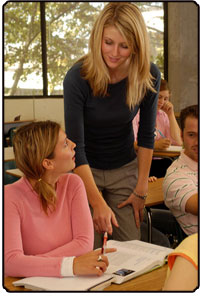
Below are some common questions asked about copyright.
What is copyright?
What is fair use?
How do we get a copyright?
Who needs to know about copyright?
What are the consequences of violating copyright?
What is UVU's policy on copyright?
Where can I go to find out more about copyright?
Didn't find your answer? Submit your question now!
Under United States copyright law, protection is provided to the authors of “original works of authorship” if such works are fixed in a tangible or material form. This means that if you can see it, hear it and/or touch it, it may be protected. Copyright subsists from the moment the work is created in fixed form. It is illegal for anyone to violate any of the rights provided by the copyright law to the owner of the copyright.
The following categories of material, whether published or unpublished, may be subject to copyright protection:
Copyright protection does not cover the ideas or concepts embodied in a work, but rather the manner of expression. In general, since 1998, for works created after 1978 the term of the copyright is the life of the author plus 50 years, or in certain circumstances, the shorter of 75 years from the year of the first publication or 100 years from the year of creation.
Only the author or those deriving their rights through the author can rightfully claim copyright. Subject to certain limitations, the owner of a copyright has the exclusive right to do and to authorize the following:
For more official U.S. government information on copyright, visit www.copyright.gov.
One of the more important limitations of copyright law for educators is the doctrine of “fair use” (title 17, U. S. Code). Section 107 contains a list of the various purposes for which the reproduction of a particular work may be considered “fair,” such as criticism, comment, news reporting, teaching, scholarship, and research. This section also sets out four factors to be considered in determining whether or not a particular use is fair:
The distinction between “fair use” and infringement may be unclear and not easily defined. There is no specific number of words, lines, or notes that may safely be taken without permission. Acknowledging the source of the copyrighted material does not substitute for obtaining permission. Copyright protects the particular way an author has expressed himself; it does not extend to any ideas, systems, or factual information conveyed in the work. The safest course is always to get permission from the copyright owner before using copyrighted material. When it is impracticable to obtain permission, use of copyrighted material should be avoided unless the doctrine of “fair use” would clearly apply to the situation.
For more detailed information on “fair use” see https://www.copyright.gov/fair-use/
Copyright exists from the moment your work is created. In general, you do not need to register your copyright; however, you might find registering helpful for the following reasons:
The United States has copyright relations with most countries throughout the world.
However, the United States does not have these relationships with every country. For
a listing of countries and the nature of their copyright relations with the United
States, see Circular 38a, International Copyright Relations of the United States.
A copyright protects original works of authorship, while a patent protects inventions
or discoveries. Ideas and discoveries are not protected by copyright law, although
the way in which they are expressed may be. A trademark protects words, phrases, symbols,
or designs identifying the source of the goods or services of the party and distinguishing
them from those of others.
Everyone needs to know about copyright! Copyright affects students, faculty and staff at UVU. It’s important to understand that copyright doesn’t just protect the work of professional writers, artists, filmmakers etc. But it also protects the papers and work by students, faculty and staff.
Copyright is to protect, not to annoy or bully. It serves as a protection so the creator of the original work is properly paid and/or recognized for their work. All produced work has a copyright and when it is duplicated, displayed, performed or used there is a chance you might be violating the copyright. The safest course of action is get permission. There are exceptions to this rule please see “Fair Use ”.
All original work is protected by copyright from its inception. Any original podcasts, class papers, media items, etc. created are considered protected by copyright. There are more formal steps that can be followed in establishing copyright, but in the United States, works published and unpublished are protected by copyright.
According to UVU’s copyright policy, it is the presumption of the policy that infringement of copyright, when it occurs, is generally not intentional. Therefore, the first action taken when the Copyright Committee or other members of the campus community become aware of infringements of copyright is to inform the infringing individual of the violation and work with them to take corrective action.
If alleged infringement by an employee persists, then the employee's supervisor shall be informed. The supervisor shall investigate allegations of copyright infringement and take action consistent with UVU discipline policy.
If alleged infringement by a student persists, then the Office of Judicial Affairs shall be informed and shall proceed in accordance with the Student Code policy.
Copyright is the exclusive legal right of the author of a creative work to control the copying of that work.